Restoring the peatlands
Every bottle of Creag Dhu donates money to restoring the peatlands and here’s why:
- Preserving the peatlands is one of the most cost-effective ways of protecting against the CO₂ emissions that impact global warming
- Peatlands cover just 3% of the earth’s surface
- The world’s peatlands store more than twice the carbon of our planet’s forests
- Peatlands store 30% of the entire planet’s soil carbon
- Peatlands are the UK’s largest carbon store
- 20% of Scotland is peatland
- Over 3 billion tonnes of carbon is contained in the UK’s peatlands
- 94% of UK peatland has been damaged or destroyed
- Peatlands store up to 70kg of carbon per cubic metre
- Saving one cubic meter of peatland is the equivalent of
– 637 miles driven in the average car,
– 33,000 mobile phone charges,
– 4 planted trees growing for 10 years


What are peatlands and what are the issues that we help with?
Peatlands are naturally waterlogged systems that slow decomposition and enable plant remains, containing carbon removed from the atmosphere by photosynthesis, to be locked in and laid down as peat. (Peatlands are also known as moors, bogs, mires, peat swamp forests, permafrost tundra, peat moss, muskegs, fens.)
Peatlands are not only beautiful, dramatic landscapes but are also important ecosystems full of inspiring wildlife. Peatlands are home to birds that like to nest in open ground, such as the curlew, snipe, golden plover and hen harrier. Red deer, mountain hares, lizards, amphibians, insect-eating sundew plants and a host of invertebrates also thrive on peatlands.
Peatlands are also incredibly important for people. 70% of Scotland’s drinking water is filtered through peatlands.
Healthy peatlands produce clean water which requires fewer chemicals to treat.
Peatland vegetation also slows the flow of rainfall, helping to prevent flooding in local towns and villages.
Peatlands represent the UK’s biggest store of carbon, accumulating over three billion tonnes of carbon, around the same amount as all the forests in the UK, France and Germany put together.
Much of the UK’s peatland, however, is no longer sequestering and storing carbon with 94% of the country’s natural peatland either destroyed or damaged. Due to previous land management practices, it has become a significant net source of greenhouse gases as it dries and degrades.
How effective is peatland restoration at mitigating climate change?
Peatland restoration is vital if we are to avoid serious environmental, economic and social harm.
If we do not act now important natural capital stands to erode: clean drinking water, carbon storage, flood mitigation and wildlife habitat and species.
Peatland restoration is a cost-effective means of addressing climate change, compared with other carbon abatement methods such as afforestation and renewable energy. Restoring peatlands can be considered a natural form of carbon capture and storage, preventing the release of carbon from damaged bogs and preserving it for potentially millions of years.
A healthy and balanced peatland must be saturated with at least 90% water.
In a healthy peatland, plants are preserved in the acidic peatland water – this prevents them from degrading and releasing their carbon as carbon dioxide into the atmosphere.
Since Roman times, ditches have been dug to drain peatlands, making them more suitable for farming, hunting and housing.
Drainage ditches wash away the peat and the dried peat starts to degrade, releasing carbon dioxide into the atmosphere. This degradation is sped up by the sun and wind, exposing dry peat to the elements.
The work that we fund and carry out at Creag Dhu is mostly done through naturally blocking and damming up drain gullies, using either hay or wooden slats. Some sections of peat are carefully cut and moved from mounds into ditches and grafted for regrowth. These processes help to permanently retain water within the peatland system and lock in all the carbon.
As the rainwater naturally increases the water levels, within two years, plants such as sphagnum moss return to the previously dried out areas. Within five to fifteen years, the land is back to being fully functioning peatlands.
Plant life and wildlife thrive on the peatlands, bursting with life throughout all seasons, deer in winter, dragonflies in summer, the fiery red sphagnum moss throughout and then once plants and wildlife die, the highland water at its perfect pH, preserves the plants and wildlife forever and prevent it from becoming CO₂ that would harm the planet.
